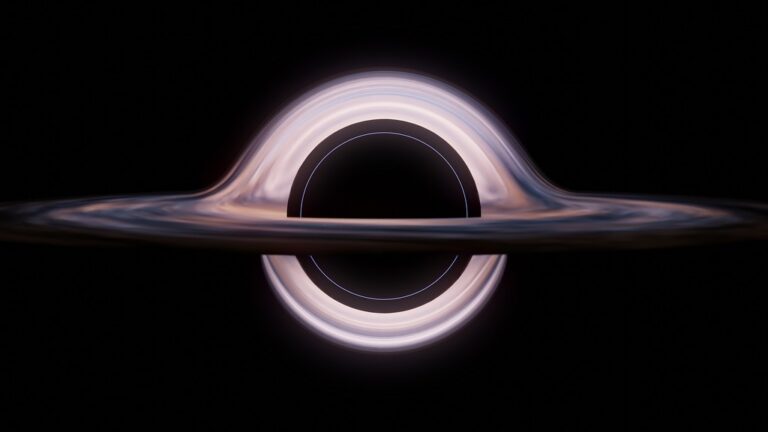Black Holes: The Cosmic Enigma
A black hole is one of the most intriguing and enigmatic phenomena in astrophysics. It is formed when a massive star exhausts its nuclear fuel and undergoes a gravitational collapse, compressing its mass into an incredibly dense point known as a singularity. The gravitational pull of this singularity is so intense that it creates a boundary called the event horizon, beyond which nothing can escape, not even light. This means that a black hole is not a “hole” in the traditional sense but a region of space where gravity has become so strong that it warps the fabric of space-time itself.
In more technical terms, black holes are categorized based on their mass and size, ranging from stellar black holes, which form from the remnants of collapsing stars, to supermassive black holes, which are found at the centers of galaxies, including our Milky Way. Despite their name, black holes are not empty voids; rather, they are regions where a vast amount of matter is compressed into a minuscule volume, creating an intense gravitational field that distorts the space-time continuum. This distortion causes light to bend and time to slow down relative to an outside observer, revealing the profound and often incomprehensible nature of these cosmic giants.
Black Holes and Earth’s Cosmic Fabric
Metaphorically, black holes can be seen as symbols of extreme gravitational forces that metaphorically pull and warp the very fabric of existence. On Earth, this concept translates into various socio-economic, political, and psychological phenomena that reflect a form of intense gravitational pull on human consciousness and societal structures. Just as a black hole’s gravitational force distorts space-time, various forms of societal dysfunctions—such as inequality, violence, and systemic injustice—can warp the ethical and moral fabric of human existence.
Consider a black hole as a metaphor for the extreme pressures exerted by deeply entrenched societal issues. For example, the profound gravity of systemic inequalities—such as poverty, discrimination, and exploitation—can create a socio-economic “event horizon,” beyond which individuals and communities find themselves unable to escape from cycles of hardship and marginalization. This metaphorical black hole draws in all aspects of existence, much like the real black hole’s event horizon draws in everything that crosses it, distorting and compressing it into a state of extreme difficulty and strife.
The Cosmic Fabric of Earth: An Observation of the Observer
The cosmic fabric of Earth, when viewed through the lens of black holes, can be interpreted as a complex interplay of gravitational and metaphysical forces shaping human experience. Just as the intense gravitational field of a black hole distorts space-time, the pervasive forces of societal dysfunction can distort the ethical and moral landscape of human societies. In this context, black holes serve as powerful symbols for the negative forces that pull and compress human potential into states of ethical and moral crisis.
For instance, the concept of systemic violence and crime, particularly against women and children, can be seen as a manifestation of the metaphorical black hole. The societal “gravity” of patriarchal structures, gender inequality, and the normalization of violence creates a distorted space where ethical and moral boundaries are frequently breached. This distortion mirrors the way in which the intense gravitational forces of a black hole warp space-time, pulling everything towards a state of extreme gravity and compression.
Similarly, the fracturing of social cohesion and the prevalence of divisive constructs—such as political polarization, racial tensions, and economic disparities—can be compared to the cosmic warping effect of a black hole. Just as a black hole’s event horizon marks the boundary beyond which escape is impossible, the fragmentation of societal structures creates barriers that prevent the resolution of deep-seated issues and perpetuate cycles of discord and inequality.
How Blackholes warp Space-Time Fabric & its moral and ethical implications ?
In the physical realm, a black hole warps the space-time fabric by creating an intense gravitational field due to its singularity—a point of infinite density. This singularity forms when a massive star collapses under its own gravity, compressing its mass into an incredibly small volume. The gravitational pull near this singularity becomes so strong that it distorts the surrounding space-time continuum.
This warping effect bends the paths of light and other forms of radiation, creating an “event horizon” beyond which nothing can escape. Essentially, space-time is curved to such an extent that all paths lead inward, preventing any matter or information from leaving the black hole’s grasp.
As per the cosmic equilibrium of observation, the warping of space-time around a black hole can be likened to a profound moral and ethical breakdown in a society. Imagine a region where the very fabric of human values and principles is pulled and twisted by the gravity of wrongdoing and corruption. Just as a black hole distorts light and time, this moral corruption bends the principles of justice and fairness to their breaking point.
The event horizon represents the point of no return, beyond which the darkness of unethical behavior and heinous crimes, like violence and exploitation, becomes inescapable. In this metaphor, the black hole symbolizes a state of extreme societal dysfunction where moral clarity is lost, and ethical boundaries collapse, trapping individuals and communities in a cycle of despair and degradation.
The Collapse and Expansion of Time: Black Holes and Human Experience
Metaphorically, the way black holes influence the perception of time can also be applied to human experiences. In the presence of a black hole, time is perceived to slow down due to the intense gravitational field. Similarly, the metaphorical black holes in human society—those extreme situations of moral decay, systemic injustice, and profound existential crises—can cause time to feel as though it is dragging on, with progress and resolution appearing to move at a glacial pace.
Conversely, in moments of joy, abundance, and ethical alignment, time appears to accelerate or even feel suspended, reflecting the expansionary effects of cosmic phenomena. When societal conditions align with ethical and moral principles, and when systems of justice and fairness are in place, there is a sense of fluidity and progression, where the pressures of societal “black holes” diminish, and the experience of time becomes more harmonious and fulfilling.
Conclusion: Black Holes as a Reflection of Earthly Realities
In summary, black holes serve as profound symbols in both their physical and metaphorical contexts. Physically, they represent regions where gravity becomes overwhelmingly intense, distorting the fabric of space-time itself. Metaphorically, they symbolize the extreme forces that shape and distort human existence, reflecting the deep-seated issues of inequality, violence, and moral crisis that pervade our world. By understanding black holes through both their actual and metaphorical significance, we gain insights into the complex and often troubling dynamics that govern our societal structures and personal experiences.
Learn More
- The Cosmic Principles & Laws of all the Universes
- The Reality of Black Holes: Non -Autonomous Deterministic Universes
- Why Charles Darwin’s Theory of Survival of the Fittest is a flawed framework
- The unifying framework of string dynamics – Cosmic Equilibrium of Creator & Creation
- How Human Behavior mirrors entire Cosmic Order through String Dynamics
- Exploring Wave Nature of Matter & its Random Nature in Cosmic Fabric
- Wave Particle Duality, String Dynamics, Randomness and its Parallels with Human Behavior



